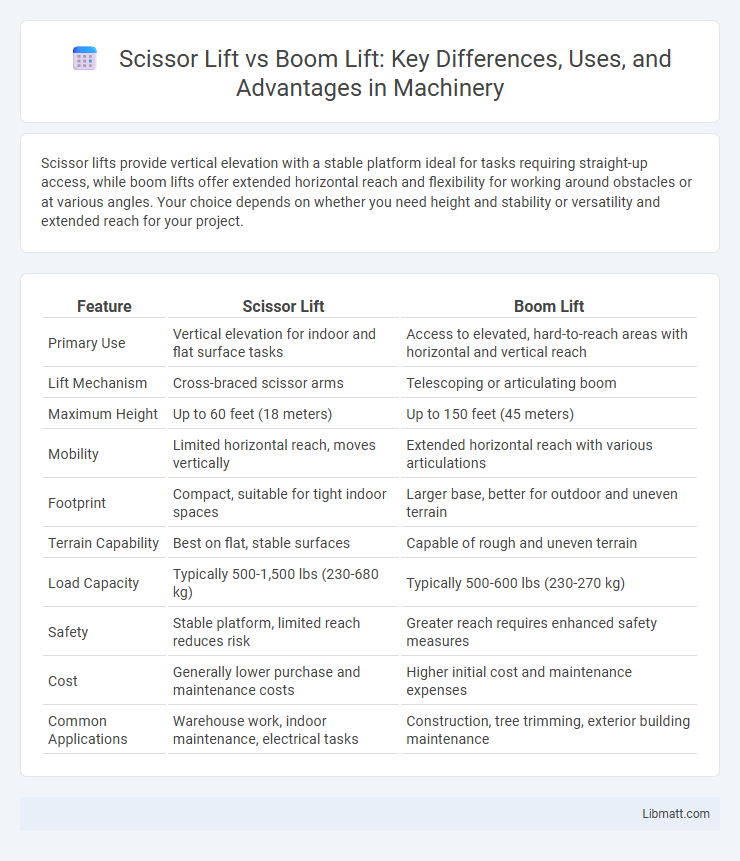Scissor lifts provide vertical elevation with a stable platform ideal for tasks requiring straight-up access, while boom lifts offer extended horizontal reach and flexibility for working around obstacles or at various angles. Your choice depends on whether you need height and stability or versatility and extended reach for your project.
Table of Comparison
| Feature | Scissor Lift | Boom Lift |
|---|---|---|
| Primary Use | Vertical elevation for indoor and flat surface tasks | Access to elevated, hard-to-reach areas with horizontal and vertical reach |
| Lift Mechanism | Cross-braced scissor arms | Telescoping or articulating boom |
| Maximum Height | Up to 60 feet (18 meters) | Up to 150 feet (45 meters) |
| Mobility | Limited horizontal reach, moves vertically | Extended horizontal reach with various articulations |
| Footprint | Compact, suitable for tight indoor spaces | Larger base, better for outdoor and uneven terrain |
| Terrain Capability | Best on flat, stable surfaces | Capable of rough and uneven terrain |
| Load Capacity | Typically 500-1,500 lbs (230-680 kg) | Typically 500-600 lbs (230-270 kg) |
| Safety | Stable platform, limited reach reduces risk | Greater reach requires enhanced safety measures |
| Cost | Generally lower purchase and maintenance costs | Higher initial cost and maintenance expenses |
| Common Applications | Warehouse work, indoor maintenance, electrical tasks | Construction, tree trimming, exterior building maintenance |
Overview: Scissor Lift vs Boom Lift
Scissor lifts provide vertical elevation with a stable platform suited for tasks requiring straight-up access, while boom lifts offer extended reach with articulated or telescopic arms ideal for accessing hard-to-reach areas at various angles. Your choice depends on the work environment and height requirements, as scissor lifts are best for indoor, flat surfaces and boom lifts excel in outdoor, uneven terrains. Understanding these distinctions ensures optimal equipment selection for safety and efficiency in material handling or maintenance projects.
Key Differences Between Scissor Lifts and Boom Lifts
Scissor lifts provide vertical elevation with a stable platform ideal for tasks requiring straight-up access, while boom lifts offer greater versatility through their extendable arms that can reach over obstacles and access hard-to-reach areas. The key differences include mobility, with boom lifts featuring articulating or telescoping booms for horizontal and vertical reach, compared to scissor lifts' limited vertical movement. Your choice depends on the specific height, reach, and maneuverability requirements of your project.
Types of Scissor Lifts
Scissor lifts come in several types, including electric, diesel, and rough terrain models, each designed for specific applications and environments. Electric scissor lifts are ideal for indoor use due to their quiet operation and zero emissions, while diesel variants provide more power and are suited for outdoor, rugged job sites. Rough terrain scissor lifts feature heavy-duty tires and enhanced stability systems to navigate uneven surfaces safely.
Types of Boom Lifts
Boom lifts include telescopic (straight) boom lifts, offering extended horizontal reach ideal for high-access jobs, and articulating (knuckle) boom lifts that provide flexible maneuverability around obstacles. Spider boom lifts are compact, versatile models designed for uneven terrain and confined spaces, often used in landscaping and maintenance. These variants differ significantly from scissor lifts, which primarily offer vertical elevation without horizontal outreach.
Applications: When to Use a Scissor Lift
Scissor lifts are ideal for tasks requiring vertical elevation in confined spaces, such as indoor maintenance, warehousing, and construction projects involving ceiling work or electrical installations. Their stable platform and compact footprint make them suitable for straight-up access without horizontal outreach, unlike boom lifts. Use a scissor lift when working on flat surfaces that demand ergonomic lifting and heavy load capacity for tools and materials.
Applications: When to Use a Boom Lift
Boom lifts are ideal for reaching elevated areas that require extended horizontal and vertical access, such as construction sites, building maintenance, and tree trimming. You should use a boom lift when working over obstacles or needing to maneuver around structures due to its ability to extend outward and provide flexible positioning. These lifts excel in applications where height and outreach are critical for safety and efficiency.
Safety Considerations for Each Lift Type
Scissor lifts provide a stable platform ideal for vertical elevation, minimizing risks related to tipping but require attention to guardrail integrity and electrical hazards. Boom lifts offer greater reach and flexibility, yet operators must be trained to manage potential fall risks and maintain safe distances from power lines. Your choice should factor in the specific work environment and mandated safety protocols to ensure optimal protection.
Cost Comparison: Scissor Lift vs Boom Lift
Scissor lifts generally cost less upfront and have lower maintenance expenses compared to boom lifts, making them more budget-friendly for tasks requiring vertical elevation. Boom lifts, although pricier, offer greater reach and versatility, justifying the higher cost for projects needing extended horizontal access. For Your investment, consider the balance between initial cost and operational flexibility when choosing between a scissor lift and a boom lift.
Pros and Cons of Scissor Lifts
Scissor lifts offer a stable platform ideal for vertical elevation in confined spaces, providing enhanced safety and ease of use for routine maintenance or construction tasks. Their compact design and ability to handle heavy loads make them cost-effective for short-term projects but limit horizontal reach compared to boom lifts. Your choice depends on the worksite requirements, with scissor lifts excelling in vertical height and load capacity while lacking the versatility and extended reach of boom lifts.
Pros and Cons of Boom Lifts
Boom lifts offer superior reach and versatility, enabling access to elevated areas up to 180 feet, making them ideal for construction, maintenance, and tree trimming. However, boom lifts tend to be more expensive than scissor lifts, with higher fuel consumption and maintenance requirements due to their complex hydraulic systems. Their maneuverability in tight spaces is limited compared to scissor lifts, and operating and safety training are essential to prevent accidents at greater heights.
Scissor lift vs boom lift Infographic

 libmatt.com
libmatt.com